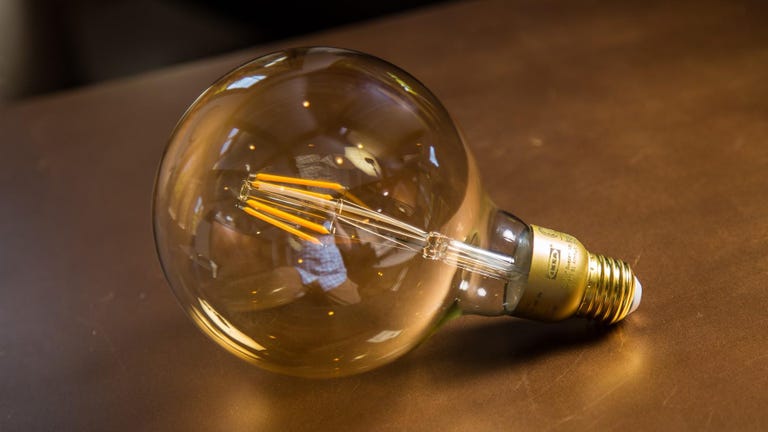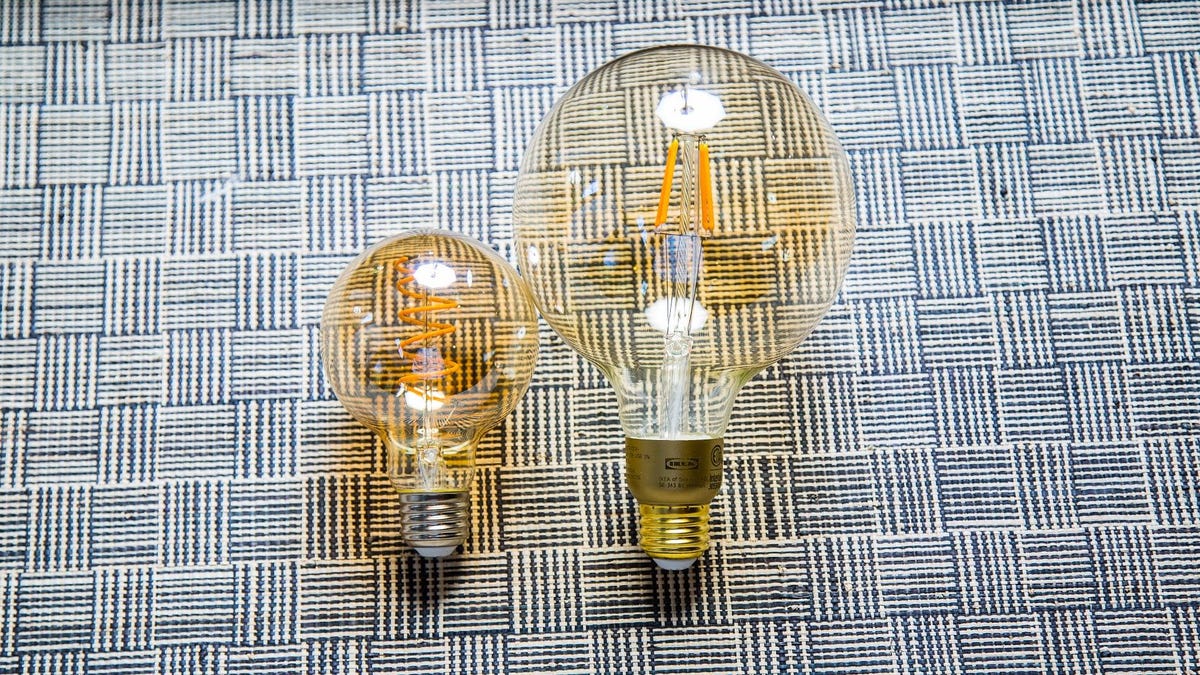 Why You Can Trust CNET
Why You Can Trust CNET Ikea Lunnom LED (400 lumen, clear brown glass) review: This big-ass bulb from Ikea offers vintage style but poor dimming
It's plenty bright and very big, but this incandescent imitator from Ikea isn't good enough on dimmer switches for us to recommend it.
I'm not sure if any of us asked for light bulbs as big as our heads, but here we are. First, Philips announced a whole lineup of king-sized LED bulbs with artful, nostalgic designs -- now, Ikea's beaten them to the punch with a big-ass bulb of its own that costs just $13.
The Good
The Bad
The Bottom Line
It's one of several bulbs in Ikea's "Lunnom" collection of vintage-style LED light bulbs that disguise themselves as old-school incandescent light bulbs -- a growing trend in the lighting aisle that seems to be connecting with consumers who are reluctant to move on from the incandescent aesthetic of the bulbs of yesteryear.
As for the appeal of light bulbs the size of cantaloupes, the idea is to use them as fixtures in and of themselves, no lampshade or sconce necessary. That makes the Ikea bulb's vintage design -- also intended for exposed bulb setups -- a nice, complementary touch.
Still, Ikea's gigantic Lunnom LED doesn't look nearly as fancy as the Philips Deco LEDs slated to arrive this fall, and while it provided more than enough brightness to qualify it as an excellent accent light, it didn't perform well on dimmer switches. That's a bummer for a bulb like this one that's made to be seen. Dial it down, and there's a good chance you'll see it flicker. That's not so bad if you don't use dimmer switches to begin with, but if you do, I say wait to see how those Philips bulbs stack up before buying in.
Ikea's Lunnom LED is much larger than other vintage-style bulbs.
Let's check the specs
Ikea pegs its jumbo-size Lunnom LED at 400 lumens bright, with a ruddy color temperature of 2,200 K. Those numbers checked out fine in my lighting lab, where I clocked it at 2,269 K and a brighter-than-advertised 465 lumens.
Ikea's bulb puts out plenty of beige-tinted light, but the arrangement of the diodes also casts some potentially ugly shadows.
That puts it roughly on par with what you'll get from 40W accent light -- and with a power draw of just 4.2W, it'll consume about 90 percent less energy. Use it for an average of 3 hours per day and it'll add about 50 cents to your yearly energy bill. For comparison, that 40W bulb would add just under $5 to your bill over the same stretch.
With a slight sepia tint to the glass, the bulb's light output looks a little beige in appearance, and appropriately warm for a vintage-style light source. Unlike some other vintage LEDs that twist their fake filaments into helices or spirals, Ikea's design leaves the diodes arranged into columns, making for a look that's less artful and more industrial. Those columns also get in the way of each other, creating shadows within the bulb's field of light. For my money, I still prefer those spiral-shaped filaments -- they're more eye-catching, and in most cases, completely free of any shadows at all.
At 465 lumens, Ikea's bulb is also brighter than a lot of other vintage-style LEDs, many of which only offer 300 lumens or so. Brighter is generally better, but with exposed bulbs like these, there's definitely such a thing as "too bright." Ikea's bulb doesn't necessarily cross that threshold, but it might flirt with it. With the bulb lit up at my desk a few feet from my face, I found myself averting my eyes from it.
Dimming performance was just so-so. Here it is with an obvious flicker at a low setting on an old rotary-style dimmer. pic.twitter.com/UjPSUTa2uI
— Ry Crist (@rycrist) June 5, 2018
What about dimmability?
If, like me, you find the bulb to be a bit too bright, then you can always use a dimmer switch to dial it down. The bulb's dimmable range was remarkably consistent across every switch I tested it with, dialing all the way down to exactly 7 lumens on each of them. That's about 1.5 percent of its full brightness, which is excellent.
The caveat to all of that is that the bulb tends to flicker when dimmed down to low or medium settings. That was my experience with two out of the three switches on my test rig -- a Leviton slider designed for LEDs and an old-school rotary dimmer from Lutron designed for incandescents. The Ikea bulb gave off a persistent, obvious flicker at low settings on the former, and occasional, shuddering flickers at medium settings on the latter.
Better dimming on this Leviton slider switch designed for LEDs, but still some persistent flicker at mid-range settings. pic.twitter.com/XAHFSSWRLZ
— Ry Crist (@rycrist) June 5, 2018
Of course, performance was nearly perfect on my third switch, a Lutron slider designed for LEDs. As always, the takeaway is that dimming performance will vary greatly depending on what hardware you're using. If you're thinking of buying in and you use dimmer switches, start with one bulb to make sure it's a good fit for your home (and hang onto the receipt in case it isn't).
It's also worth noting that dimming performance seems to be a bit of a challenge for vintage-style bulbs like these, perhaps because of the unique arrangement of the diodes. The only ones I've tested so far that have aced my dimming tests: the newest vintage-style bulbs from GE. None of those are as jumbo-size as what Ikea's offering, but if you need your bulbs to dim, they're currently your best bet in the vintage category.
The verdict
At $13, Ikea's largest light bulb is a decent, design-minded LED at a relatively fair price, and an interesting option for folks looking for a more creative approach to in-home lighting. The boom in LED bulbs and smart lighting options have led a lot of us to reconsider how our light bulbs can factor into our home's decor, and while jumbo bulbs like this one certainly aren't for everyone, I'm glad to have the option.
Still, there are shortcomings here that stop me from recommending it. I don't like that the bulb's fake filaments cast shadows, especially since competitors like Feit and GE have shown that it's an avoidable problem. Even worse, the flickering performance on dimmer switches leaves too much to be desired. If you're intrigued at the thought of bulbs as big as this, I say hold out for better options.



